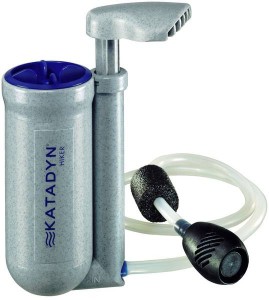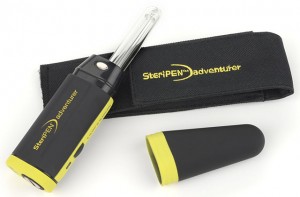
Portable water treatment systems are a must for anyone trekking in the outdoors. Water treatment systems eliminate parasites and bacteria from the water, making it safe to drink. Various manufacturers use different methods to eliminate micro organisms in contaminated water. How effective they are is another matter that is constantly being debated. While all treatment methods are effective, the standards set by The Environmental Protection Agency, require that a water treatment system must eliminate 99.99 percent of micro organisms. Essentially, there are two ways to treat water. You can either kill or filter-out the microorganisms in the water you treat. Some manufacturers of water treatment systems choose one over the other, while some do both. Depending on how you plan on using a water treatment system will help you decide which system is best for you. If you’re an avid hiker and backpacker, estimate the amount of water you’ll be using on a given outing. If you plan on doing excursions into other countries and aren’t familiar with the water sources, a system that kills and filters out organisms and viruses may be better for you.
Filtration Methods
One of the most common methods of eliminating microorganisms from water is by use of a filtration system. Most manufacturers of portable water treatment systems, who use filters, go beyond these numbers but consumers must be aware of how manufacturers test their filtration methods. The amount of water passing through the filter for a specific test may be different from one filtration system to the next. So when selecting the right filtration system for you, it’s always a good idea to compare apples to apples.

Filters typically prevent organisms from passing through its structure that depend on the pore size of the filter matrix and the design of the filter. Some filter matrix’s have a consistent pore size that can achieve an “absolute” micron rating. Other designs have a variable pore size that have an “average” micron rating. Membrane filters are effective inexpensive and are normally used with a chemical to kill any organisms that make it through its non-consistent pore size and are often discarded after a certain amount of water is filtered through it. Ceramic cartridge filters can be easily cleaned and reused. They can treat many more gallons of water and are typically one of most expensive.
Carbon block filters remove micro organisms as well as impurities and chemicals in the water, which also help to make it taste better. Labrynth depth filters are made from a maze of cleaning surfaces that trap micro organisms while letting the water pass through. They are coated with cleansing materials to destroy the organisms trapped within the filter. Structured matrix filters have incredibly small pores that allow a single filter to safely eliminate all contaminants, including chemicals and bacteria. Although these filters have small micron ratings they are “absolute” with a consistent pore size throughout the matrix.
Treatment Methods
Perhaps one of the most popular methods to kill bacteria and microorganisms in water is to simply boil it. Boiling several gallons of water for 3-5 minutes is a sure way to drink safe water. While boiled water may not always taste great, an old Boy Scout trick is to re-oxygenate the water by simply letting it cool and pouring it back and forth between two containers.

Another popular method used for many years has been to use iodine tablets. While iodine tablets and drops are readily available, but often lead to a bad taste. There is also some debate as to the types of organisms that iodine can kill, such as cyclospora. This is especially important if you head to foreign countries or areas in which you are unsure of the water sources. In addition, some people have an allergic reaction to iodine that may cause additional problems. While chlorine is also another popular method of treating water, the most common complaint to its use is taste. There is also debate as to its effectiveness in killing Giardia, a common organism found in back country rivers and streams. Some new iodine and chemical treatment kits also include a neutralizer to eliminate the iodine aftertaste and color.
One of the newest methods of water treatment systems utilize ultraviolet (UV-C) light rays to safely sterilize clear water. The ultraviolet light destroys 99.99 percent of protozoa, bacteria and even viruses. While this method is still relatively new to outdoor enthusiasts, the technology has proven to be safe and effective.
Best Bets
No matter what type of water treatment system you use, make sure that you take the water from the cleanest source possible. If piped water is available fill up your bladders and water bottles here first and take enough for your day trip. Longer routes may require taking water from areas along your route. Running springs or creeks are your best source, as micro organisms don’t have much time to settle to the bottom. Keep in mind that most organisms are normally found floating on top of the water. Therefore, many water treatment devices have a float or weighted hose that keeps the inlet at the correct depth, while also eliminating chances of it resting on the bottom.
Ponds and lakes offer the highest level of microorganism contamination. In many cases, even though your water treatment method my be extremely effective, it’s a good idea to gather up some water in a bucket or pot and treat it first by boiling or adding iodine tablets. Then you can pump it through your filter. Filters that use carbon, and iodine-laced filters have an advantage to removing the iodine residue, allowing the water to taste good. Care should be taken however, to ensure that the iodine-lased filter has enough time to effectively kill the organisms before being removed by the carbon.
Which ever filter you use, follow the instructions carefully and use common sense. Keep the filter inlet and outlet hose separate to avoid possible contamination. In any case, the best way to keep you safe on all your outdoor adventures is to use common sense. Having a parasite inside you can be one of the most painful and gut-wrenching experiences you could ever imagine. Therefore, when it comes to your drinking water, it’s always better to be safe than sorry.
By: Dan Sanchez
One thought on “Choosing A Water Treatment System”